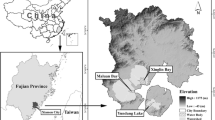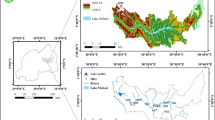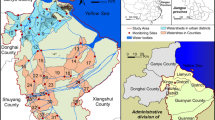Abstract
This paper aims to assess the influence of land use and land cover (LULC) indicators and population density on water quality parameters during dry and rainy seasons in a tourism area in Indonesia. This study applies least squares regression (OLS) and Pearson correlation analysis to see the relationship among factors, and all LULC and population density were significantly correlated with most of water quality parameter with P values of 0.01 and 0.05. For example, DO shows high correlation with population density, farm, and built-up in dry season; however, each observation point has different percentages of LULC and population density. The concentration value should be different over space since watershed characteristics and pollutions sources are not the same in the diverse locations. The geographically weighted regression (GWR) analyze the spatially varying relationships among population density, LULC categories (i.e., built-up areas, rice fields, farms, and forests), and 11 water quality indicators across three selected rivers (Ayung, Badung, and Mati) with different levels of tourism urbanization in Bali Province, Indonesia. The results explore that compared with OLS estimates, GWR performed well in terms of their R2 values and the Akaike information criterion (AIC) in all the parameters and seasons. Further, the findings exhibit population density as a critical indicator having a highly significant association with BOD and E. Coli parameters. Moreover, the built-up area has correlated positively to the water quality parameters (Ni, Pb, KMnO4 and TSS). The parameter DO is associated negatively with the built-up area, which indicates increasing built-up area tends to deteriorate the water quality. Hence, our findings can be used as input to provide a reference to the local governments and stakeholders for issuing policy on water and LULC for achieving a sustainable water environment in this region.








Similar content being viewed by others
Data availability
All data generated or analyzed during this study are included in this published article )and its supplementary information files_. The raw archive data are available at Bali-Penida Watershed Office (BWS) Bali, Statistic Bureau of Bali Province, Geospatial Information Agency (BIG) and USGS.
References
Brooks BW, Conkle JL (2019) Commentary: perspectives on aquaculture, urbanization and water quality. Comp Biochem Physiol Part - C Toxicol Pharmacol 217:1–4. https://doi.org/10.1016/j.cbpc.2018.11.014
Brunsdont C, Fotheringham S, Chariton M (2016) Geographically weighted regression-modelling spatial non-stationarity. J R Stat Soc Series D ( The Statistician ), Vol . 47 , No . 3 Published by 47:431–443
Butler BA, Ford RG (2018) Bewertung der Beziehungen zwischen der Gesamtsumme gelöster Feststoffe und der gesamten Schwebstoff-Fracht in einem bergbaubeeinflussten Wassereinzugsgebiet. Mine Water Environ 37:18–30. https://doi.org/10.1007/s10230-017-0484-y
BWS (2019) Publikasi Data Hidrologi dan Kualitas Air Provinsi Bali 2007–2018. Kementrian Pekerjaan Umum dan Perumahan Rakyat Direktorat Jenderal Sumber Daya Air Balai Wilayah Sungai Bali-Penida
Campbell JB (2008) Introduction to remote sensing. Guildford Press
Chao L, Zhang K, Li Z, Zhu Y, Wang J, Yu Z (2018) Geographically weighted regression based methods for merging satellite and gauge precipitation. J Hydrol 558:275–289. https://doi.org/10.1016/j.jhydrol.2018.01.042
Chen Q, Mei K, Dahlgren RA, Wang T, Gong J, Zhang M (2016) Impacts of land use and population density on seasonal surface water quality using a modified geographically weighted regression. Sci Total Environ 572:450–466. https://doi.org/10.1016/j.scitotenv.2016.08.052
de Mello K, Valente RA, Randhir TO et al (2018a) Effects of land use and land cover on water quality of low-order streams in southeastern Brazil: watershed versus riparian zone. Catena 167:130–138. https://doi.org/10.1016/j.catena.2018.04.027
de Mello K, Valente RA, Randhir TO, Vettorazzi CA (2018b) Impacts of tropical forest cover on water quality in agricultural watersheds in southeastern Brazil. Ecol Indic 93:1293–1301. https://doi.org/10.1016/j.ecolind.2018.06.030
Dinas Pariwisara Provinsi Bali (2019) Statistik Wisman tahun 2018. Dinas Pariwisara Provinsi Bali https://doi.org/10.1017/CBO9781107415324.004
Fotheringham AS, Charlton ME, Brunsdon C (2001) Spatial variations in school performance: a local analysis using geographically weighted regression. Geogr Environ Model 5:43–66. https://doi.org/10.1080/13615930120032617
Govenor H, Krometis LAH, Willis L, Angermeier PL, Hession WC (2019) Macroinvertebrate sensitivity thresholds for sediment in Virginia streams. Integr Environ Assess Manag 15:77–92. https://doi.org/10.1002/ieam.4086
Hellweger FL, Schlosser P, Lall U, Weissel JK (2004) Use of satellite imagery for water quality studies in New York Harbor. Estuar Coast Shelf Sci 61:437–448. https://doi.org/10.1016/j.ecss.2004.06.019
Hu D, Zhang C, Ma B, Liu Z, Yang X, Yang L (2020) The characteristics of rainfall runoff pollution and its driving factors in Northwest semiarid region of China - A case study of Xi ’ an. Sci Total Environ 726:138384. https://doi.org/10.1016/j.scitotenv.2020.138384
Huang J, Zhan J, Yan H, Wu F, Deng X (2013) Evaluation of the impacts of land use on water quality: a case study in the Chaohu lake basin. Sci World J 2013:1–7. https://doi.org/10.1155/2013/329187
Huang J, Huang Y, Pontius RG, Zhang Z (2015) Geographically weighted regression to measure spatial variations in correlations between water pollution versus land use in a coastal watershed. Ocean Coast Manag 103:14–24. https://doi.org/10.1016/j.ocecoaman.2014.10.007
Kocasoy G, Mutlu HI, Aylin Zeren Alagöz B (2008) Prevention of marine environment pollution at the tourism regions by the application of a simple method for the domestic wastewater. Desalination 226:21–37. https://doi.org/10.1016/j.desal.2007.03.018
Larson KL, White DD, Gober P, Wutich A (2015) Decision-making under uncertainty for water sustainability and urban climate change adaptation. Sustain 7:14761–14784. https://doi.org/10.3390/su71114761
Larsson J, Smolarz K, Świeżak J, Turower M, Czerniawska N, Grahn M (2018) Multi biomarker analysis of pollution effect on resident populations of blue mussels from the Baltic Sea. Aquat Toxicol 198:240–256. https://doi.org/10.1016/j.aquatox.2018.02.024
Li K, Fang L, He L (2019) How population and energy price affect China’s environmental pollution? Energy Policy 129:386–396. https://doi.org/10.1016/j.enpol.2019.02.020
Liang W, Yang M (2019) Urbanization, economic growth and environmental pollution: evidence from China. Sustain Comput Informatics Syst 21:1–9. https://doi.org/10.1016/j.suscom.2018.11.007
Liang L, Wang Z, Li J (2019) The effect of urbanization on environmental pollution in rapidly developing urban agglomerations. J Clean Prod 237:117649. https://doi.org/10.1016/j.jclepro.2019.117649
Ma Y, Hao S, Zhao H, Fang J, Zhao J, Li X (2018) Pollutant transport analysis and source apportionment of the entire non-point source pollution process in separate sewer systems. Chemosphere 211:557–565. https://doi.org/10.1016/j.chemosphere.2018.07.184
Ning B, He Y (2007) Tourism development and water pollution: case study in Lijiang ancient town. Zhongguo Renkou Ziyuan Yu Huan Jing/ China Popul Resour Environ 17:123–127. https://doi.org/10.1016/s1872-583x(08)60006-6
Nuarsa W, As-Syakur AR, Gunadi IGA, Sukewijaya IM (2018) Changes in gross primary production (GPP) over the past two decades due to land use conversion in a tourism city. ISPRS Int J Geo-Inform 7:57. https://doi.org/10.3390/ijgi7020057
Pratt B, Chang H (2012) Effects of land cover, topography, and built structure on seasonal water quality at multiple spatial scales. J Hazard Mater 209–210:48–58. https://doi.org/10.1016/j.jhazmat.2011.12.068
Qin H-P, He K-M, Fu G (2016) Modeling middle and final flush effects of urban runoff pollution in an urbanizing catchment. J Hydrol 534:638–647. https://doi.org/10.1016/j.jhydrol.2016.01.038
Qin H, Huang Q, Zhang Z, Lu Y, Li M, Xu L, Chen Z (2019) Carbon dioxide emission driving factors analysis and policy implications of Chinese cities: combining geographically weighted regression with two-step cluster. Sci Total Environ 684:413–424. https://doi.org/10.1016/j.scitotenv.2019.05.352
Rarasari DMG, Restu IW, Ernawati NM (2018) Efektivitas Pengolahan Limbah Domestik di Instalasi Pengolahan Air Limbah (IPAL) Suwung-Denpasar, Bali. J Mar Aquat Sci 5:153. https://doi.org/10.24843/jmas.2019.v05.i02.p01
Rimba AB, Chapagain SK, Masago Y, et al (2019) Investigating water sustainability and land use/land cover change (LULC) as the impact of tourism activity in Bali, Indonesia. In: IGARSS 2019–2019 IEEE International Geoscience and Remote Sensing Symposium. https://ieeexplore.ieee.org/document/8900060, Yokohama, Japan, Japan, pp 6531–6534. Accessed 28 July-2 Aug 2019
Rimba AB, Atmaja T, Mohan G, Chapagain SK, Arumansawang A, Payus C, Fukushi K (2020) Identifying land use and land cover (LULC) change from 2000 to 2025 driven by tourism growth: a study case in Bali. ISPRS Ann Photogramm Remote Sens Spat Inf Sci XLIII:1621–1627. https://doi.org/10.5194/isprs-archives-XLIII-B3-2020-1621-2020
Rodenburg EE (1980) The effects of scale in economic development. Tourism in Bali. Ann Tour Res 7:177–196. https://doi.org/10.1016/0160-7383(80)90003-1
Setiawan O (2012) Analisis variabilitas curah hujan dan suhu di Bali. J Anal Kebijak Kehutan 9:66–79
Soler IP, Gemar G (2018) Hedonic price models with geographically weighted regression: an application to hospitality. J Destin Mark Manag 9:126–137. https://doi.org/10.1016/j.jdmm.2017.12.001
Song P, Huang J, Mansaray LR (2019) An improved surface soil moisture downscaling approach over cloudy areas based on geographically weighted regression. Agric For Meteorol 275:146–158. https://doi.org/10.1016/j.agrformet.2019.05.022
Suteja Y, Dirgayusa IGNP, Purwiyanto AIS (2020) Chromium in Benoa Bay, Bali - Indonesia. Mar Pollut Bull 153:111017. https://doi.org/10.1016/j.marpolbul.2020.111017
Tu J (2011) Spatially varying relationships between land use and water quality across an urbanization gradient explored by geographically weighted regression. Appl Geogr 31:376–392. https://doi.org/10.1016/j.apgeog.2010.08.001
Tu J, Xia ZG (2008) Examining spatially varying relationships between land use and water quality using geographically weighted regression I: model design and evaluation. Sci Total Environ 407:358–378. https://doi.org/10.1016/j.scitotenv.2008.09.031
UNEP (2005) Making tourism more sustainable - a guide for policy makers (English version). Mak tour more sustain - a Guid policy makers (English version). https://doi.org/10.18111/9789284408214
Wang Q, Ni J, Tenhunen J (2005) Application of a geographically-weighted regression analysis to estimate net primary production of Chinese forest ecosystems. Glob Ecol Biogeogr 14:379–393. https://doi.org/10.1111/j.1466-822X.2005.00153.x
Wang Y, Li X, Kang Y, Chen W, Zhao M, Li W (2019) Analyzing the impact of urbanization quality on CO 2 emissions: what can geographically weighted regression tell us? Renew Sust Energ Rev 104:127–136. https://doi.org/10.1016/j.rser.2019.01.028
Wang B, Zheng X, Zhang H, Xiao F, Gu H, Zhang K, He Z, Liu X, Yan Q (2020) Bacterial community responses to tourism development in the Xixi National Wetland Park, China. Sci Total Environ 720:137570. https://doi.org/10.1016/j.scitotenv.2020.137570
Wijesiri B, Egodawatta P, McGree J, Goonetilleke A (2015) Influence of pollutant build-up on variability in wash-off from urban road surfaces. Sci Total Environ 527–528:344–350. https://doi.org/10.1016/j.scitotenv.2015.04.093
Williamson JG (1988) Chapter 11 migration and urbanization. Handb Dev Econ 1:425–465. https://doi.org/10.1016/S1573-4471(88)01014-9
Zhang F, Yang X (2020) Improving land cover classification in an urbanized coastal area by random forests: the role of variable selection. Remote Sens Environ 251:112105. https://doi.org/10.1016/j.rse.2020.112105
Zhao C, Yang S, Liu J, Liu C, Hao F, Wang Z, Zhang H, Song J, Mitrovic SM, Lim RP (2018) Linking fish tolerance to water quality criteria for the assessment of environmental flows: a practical method for streamflow regulation and pollution control. Water Res 141:96–108. https://doi.org/10.1016/j.watres.2018.05.025
Zhao CS, Shao NF, Yang ST, Ren H, Ge YR, Zhang ZS, Feng P, Liu WL (2019) Quantitative assessment of the effects of human activities on phytoplankton communities in lakes and reservoirs. Sci Total Environ 665:213–225. https://doi.org/10.1016/j.scitotenv.2019.02.117
Zhou Q, Wang C, Fang S (2019) Application of geographically weighted regression (GWR) in the analysis of the cause of haze pollution in China. Atmos Pollut Res 10:835–846. https://doi.org/10.1016/j.apr.2018.12.012
Zinia NJ, Kroeze C (2015) Future trends in urbanization and coastal water pollution in the bay of Bengal: the lived experience. Environ Dev Sustain 17:531–546. https://doi.org/10.1007/s10668-014-9558-1
Boots B (2003) Developing local measures of spatial association for categorical data. J Geograph Syst 5:139–160. https://doi.org/10.1007/s10109-003-0110-3
BPS (2018) Bali Province in figures 2018. Denpasar
Abd EL-kawy OR, Ismail HA, Yehia HM, Allam MA (2019) Temporal detection and prediction of agricultural land consumption by urbanization using remote sensing. Egypt J Remote Sens Sp Sci 22:237–246. https://doi.org/10.1016/j.ejrs.2019.05.001
Ahmed B (2011) Urban land cover change detection analysis and modeling spatio-temporal growth dynamics using remote sensing and GIS techniques: a case study of Dhaka, Bangladesh
Al-khudhairy D and Shepherd I (1997) Changes in land-use and land-cover: a cause of flooding? A literature review. Eur Comm Jt Res centre; Inst Syst Informatics Safety; Ispra (VA)- Italy
Antara M, Sumarniasih MS (2018) Role of tourism in economy of Bali and Indonesia. J Tour Hosp Manag 5:34–44. https://doi.org/10.15640/jthm.v5n2a4
Acknowledgments
We would like to thank JSPS, UNU-IAS WSD Team, the Bali-Penida Watershed Office, especially the head of BWS and BWS staff, Ms. Nanda, Statistic Bureau of Bali Province, Geospatial Information Agency (BIG) and USGS for providing water quality and remote-sensing data. Additionally, we thank the Center for Remote Sensing and Ocean Sciences (CReSOS)-Udayana University and the Research Center of Environmental Studies (PPLH)-Udayana University as the local partner in Bali Province that helped the authors with data collection and field surveys. Finally, thank you to all those who helped to prepare this manuscript, especially to the reviewers for their constructive comments.
Funding
This research was supported by the Japan Society for the Promotion of Science (JSPS). This research is part of the Water for Sustainable Development (WSD) project of the United Nations University-Institute for the Advanced Study of Sustainability (UNU-IAS).
Author information
Authors and Affiliations
Contributions
Andi Besse Rimba: conceptualization, methodology, GIS and remote sensing analysis, writing of original draft, and field survey. Geetha Mohan: supervision, statistical analysis, writing of review, and editing. Saroj Kumar Chapagain: supervision, review, and editing. Andi Arumansawang: field survey, review, and editing. Kensuke Fukushi: supervision and review. Husnayaen and Takahiro Osawa: field survey and review. All authors read and approved the final manuscript.
Corresponding author
Ethics declarations
Ethical approval, consent to participate, and consent to publish
Not applicable.
Competing interests
The authors declare that they have no competing interests.
Additional information
Responsible Editor: Philippe Garrigues
Publisher’s note
Springer Nature remains neutral with regard to jurisdictional claims in published maps and institutional affiliations.
Rights and permissions
About this article
Cite this article
Rimba, A.B., Mohan, G., Chapagain, S.K. et al. Impact of population growth and land use and land cover (LULC) changes on water quality in tourism-dependent economies using a geographically weighted regression approach. Environ Sci Pollut Res 28, 25920–25938 (2021). https://doi.org/10.1007/s11356-020-12285-8
Received:
Accepted:
Published:
Issue Date:
DOI: https://doi.org/10.1007/s11356-020-12285-8




